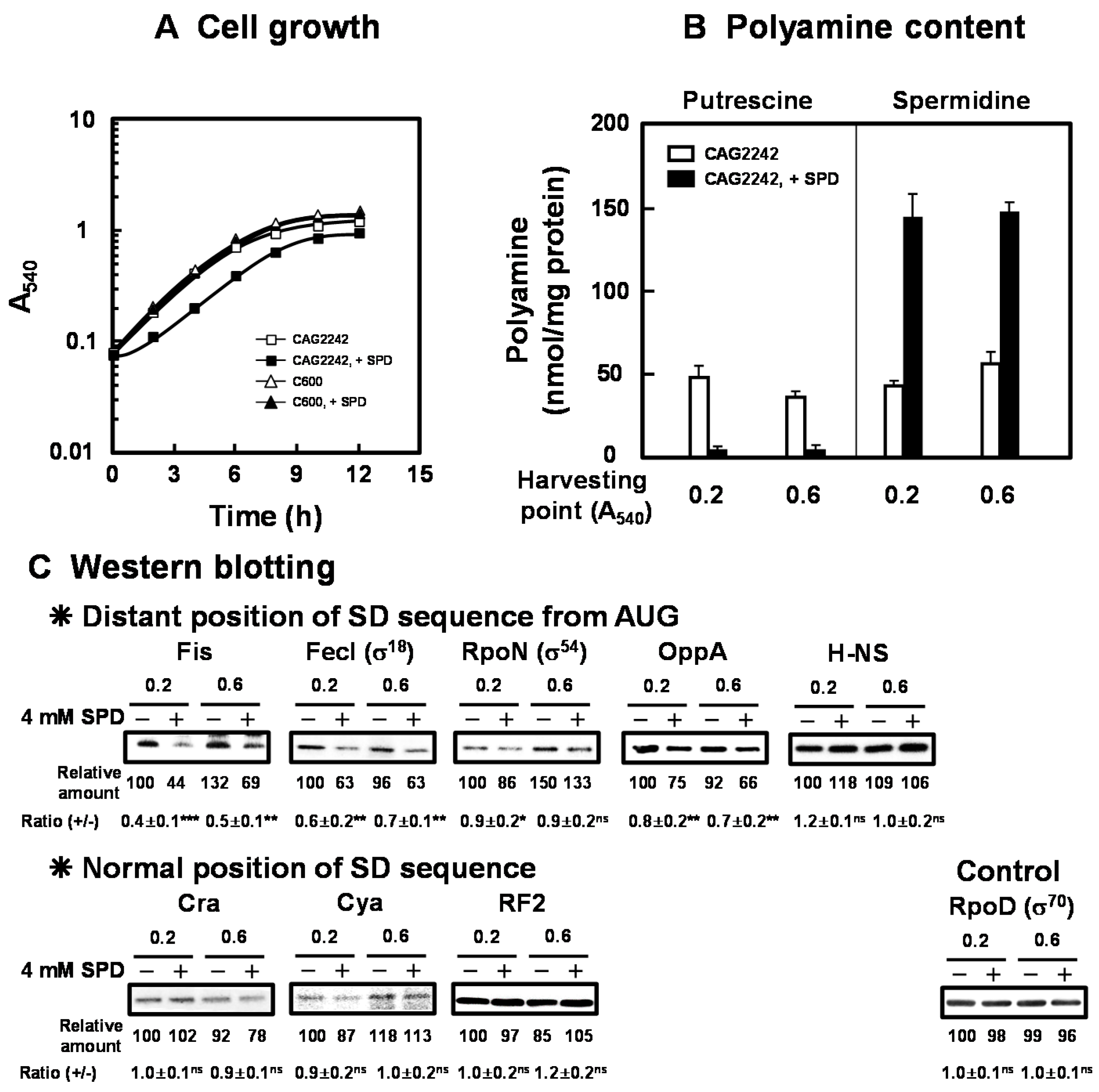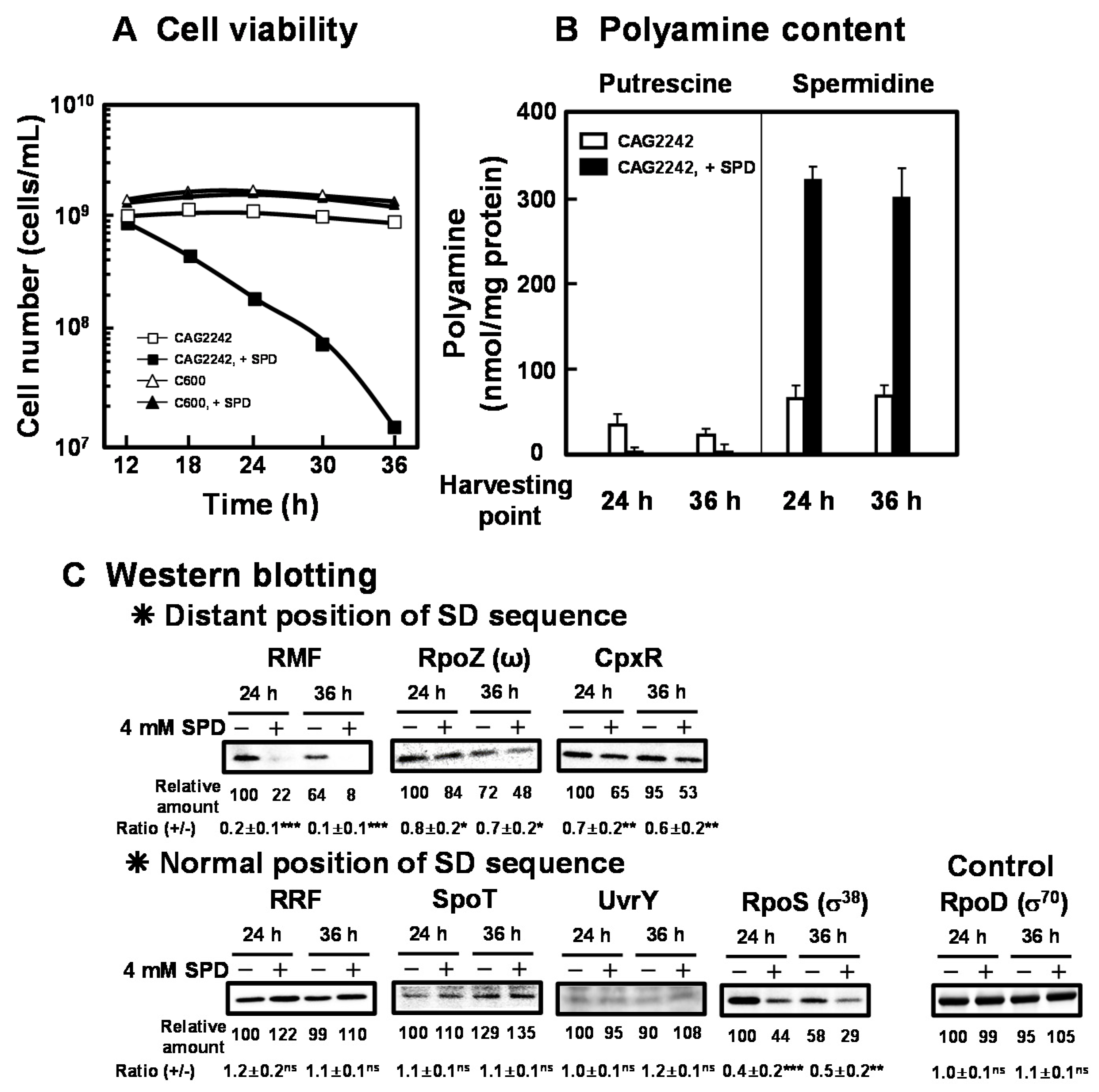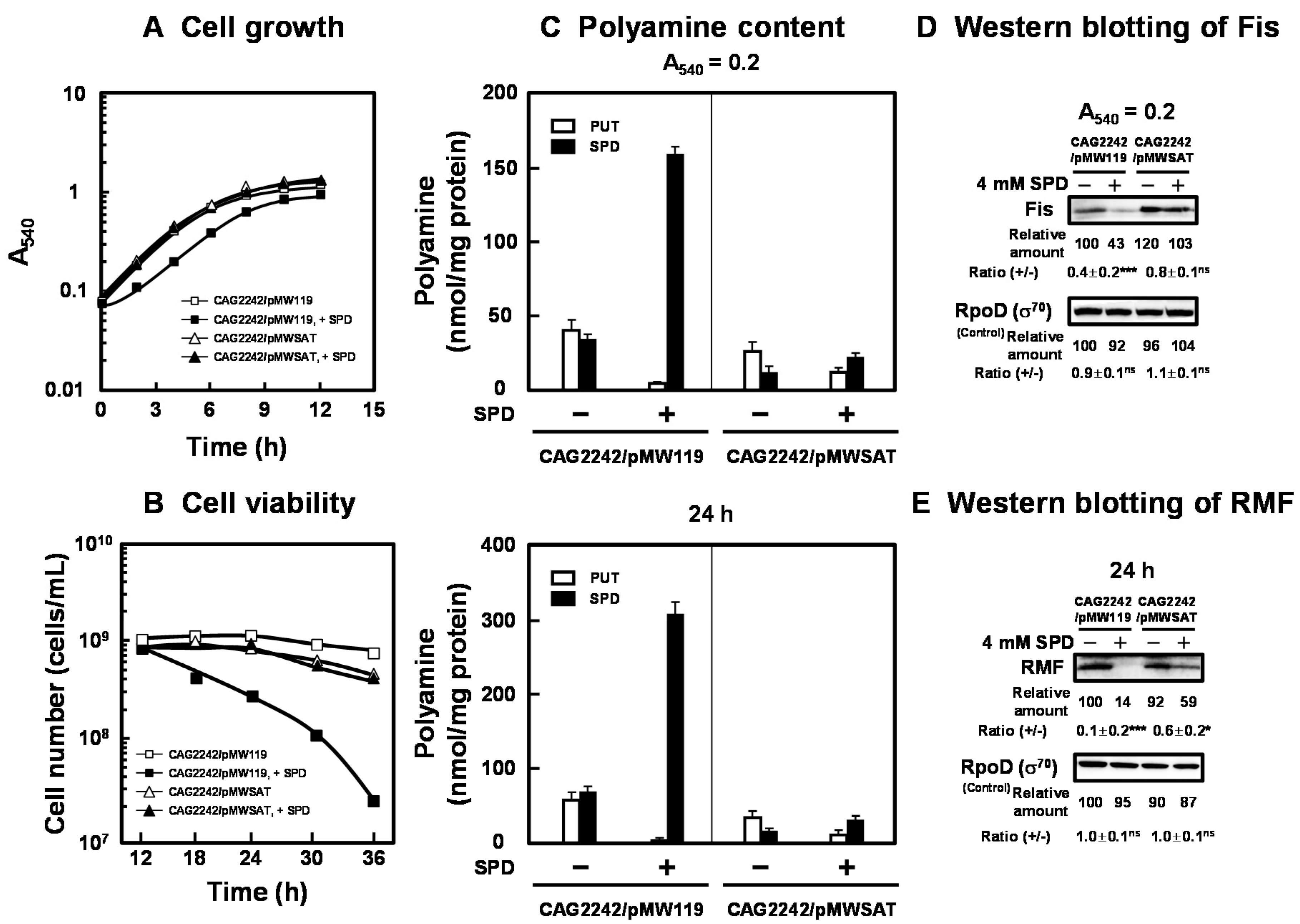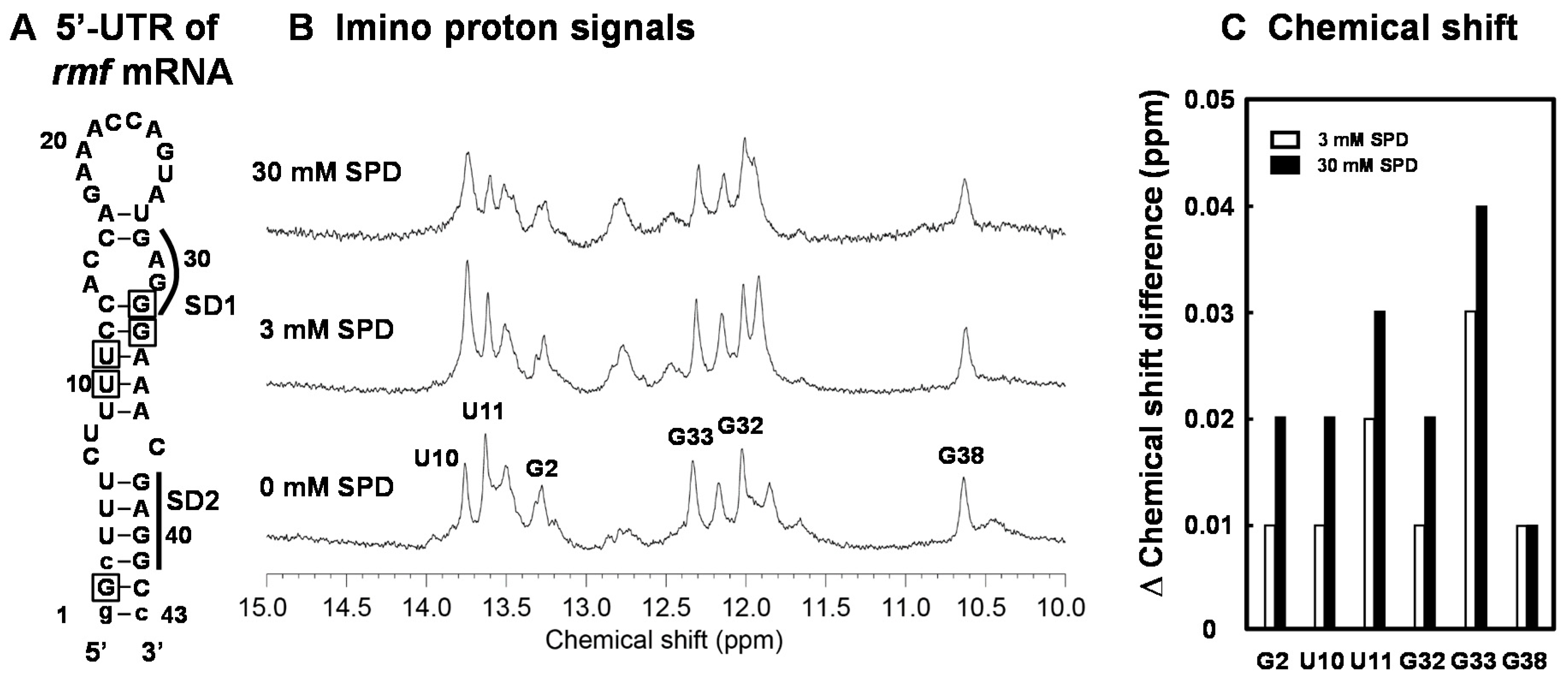Cytotoxic Mechanism of Excess Polyamines Functions through Translational Repression of Specific Proteins Encoded by Polyamine Modulon
Abstract
1. Introduction
2. Results
2.1. Correlation between the Decrease in Cell Growth and Translation of Proteins Encoded by Polyamine Modulon in Response to Excess Spermidine
2.2. Correlation between the Decrease in Cell Viability and Translation of Proteins Encoded by Polyamine Modulon in Response to Excess Spermidine
2.3. Recovery of Cell Growth and Viability by Transformation of the Gene Encoding Spermidine Acetyltransferase
2.4. Analysis by NMR of the Structural Change of the Bulged-out Region at the Initiation Site of the rmf mRNA by SPD
3. Discussion
4. Materials and Methods
4.1. Bacterial Strains, Culture Conditions, and Plasmid
4.2. Measurement of Polyamine Contents
4.3. Western Blot Analysis
4.4. Prediction of the Secondary Structure of RNA
4.5. Preparation of the RNA
4.6. NMR Measurements and Signal Assignment
Supplementary Materials
Author Contributions
Funding
Acknowledgments
Conflicts of Interest
Abbreviations
| NMR | nuclear magnetic resonance |
| ppGpp | guanosine 5′-diphosphate 3′-diphosphate |
| PUT | putrescine |
| SAT | spermidine acetyltransferase |
| SD | Shine–Dalgarno |
| SPD | spermidine |
| SPM | spermine |
References
- Pegg, A.E. Introduction to the Thematic Minireview Series: Sixty plus years of polyamine research. J. Biol. Chem. 2018, 293, 18681–18692. [Google Scholar] [CrossRef] [PubMed]
- Brunton, V.G.; Grant, M.H.; Wallace, H.M. Spermine toxicity and glutathione depletion in BHK-21/C13 cells. Biochem. Pharmacol. 1990, 40, 1893–1900. [Google Scholar] [CrossRef]
- Mandal, S.; Mandal, A.; Johansson, H.E.; Orjalo, A.V.; Park, M.H. Depletion of cellular polyamines, spermidine and spermine, causes a total arrest in translation and growth in mammalian cells. Proc. Natl. Acad. Sci. USA 2013, 110, 2169–2174. [Google Scholar] [CrossRef] [PubMed]
- Yoshida, M.; Tomitori, H.; Machi, Y.; Hagihara, M.; Higashi, K.; Goda, H.; Ohya, T.; Niitsu, M.; Kashiwagi, K.; Igarashi, K. Acrolein toxicity: Comparison with reactive oxygen species. Biochem. Biophys. Res. Commun. 2009, 378, 313–318. [Google Scholar] [CrossRef]
- Michael, A.J. Polyamines in eukaryotes, bacteria, and archaea. J. Biol. Chem. 2016, 291, 14896–14903. [Google Scholar] [CrossRef]
- Miyamoto, S.; Kashiwagi, K.; Ito, K.; Watanabe, S.; Igarashi, K. Estimation of polyamine distribution and polyamine stimulation of protein synthesis in Escherichia coli. Arch. Biochem. Biophys. 1993, 300, 63–68. [Google Scholar] [CrossRef]
- Igarashi, K.; Kashiwagi, K.; Aoki, R.; Kojima, M.; Hirose, S. Comparative studies on the increase by polyamines of fidelity of protein synthesis in Escherichia coli and wheat germ cell-free systems. Biochem. Biophys. Res. Commun. 1979, 91, 440–448. [Google Scholar] [CrossRef]
- Jelenc, P.C.; Kurland, C.G. Nucleoside triphosphate regeneration decreases the frequency of translation errors. Proc. Natl. Acad. Sci. USA 1979, 76, 3174–3178. [Google Scholar] [CrossRef]
- Echandi, G.; Algranati, I.D. Defective 30S ribosomal particles in a polyamine auxotroph of Escherichia coli. Biochem. Biophys. Res. Commun. 1975, 67, 1185–1191. [Google Scholar] [CrossRef]
- Igarashi, K.; Kashiwagi, K.; Kishida, K.; Watanabe, Y.; Kogo, A.; Hirose, S. Defect in the split proteins of 30-S ribosomal subunits and under-methylation of 16-S ribosomal RNA in a polyamine-requiring mutant of Escherichia coli grown in the absence of polyamines. Eur. J. Biochem. 1979, 93, 345–353. [Google Scholar] [CrossRef]
- Igarashi, K.; Kashiwagi, K. Modulation of cellular function by polyamines. Int. J. Biochem. Cell Biol. 2010, 42, 39–51. [Google Scholar] [CrossRef] [PubMed]
- Igarashi, K.; Kashiwagi, K. Modulation of protein synthesis by polyamines. IUBMB Life 2015, 67, 160–169. [Google Scholar] [CrossRef] [PubMed]
- Igarashi, K.; Kashiwagi, K. Effects of polyamines on protein synthesis and growth of Escherichia coli. J. Biol. Chem. 2018, 293, 18702–18709. [Google Scholar] [CrossRef] [PubMed]
- Higashi, K.; Terui, Y.; Suganami, A.; Tamura, Y.; Nishimura, K.; Kashiwagi, K.; Igarashi, K. Selective structural change by spermidine in the bulged-out region of double-stranded RNA and its effect on RNA function. J. Biol. Chem. 2008, 283, 32989–32994. [Google Scholar] [CrossRef]
- Carper, S.W.; Willis, D.G.; Manning, K.A.; Gerner, E.W. Spermidine acetylation in response to a variety of stresses in Escherichia coli. J. Biol. Chem. 1991, 266, 12439–12441. [Google Scholar] [PubMed]
- Limsuwun, K.; Jones, P.G. Spermidine acetyltransferase is required to prevent spermidine toxicity at low temperatures in Escherichia coli. J. Bacteriol. 2000, 182, 5373–5380. [Google Scholar] [CrossRef]
- Schneider, B.L.; Hernandez, V.J.; Reitzer, L. Putrescine catabolism is a metabolic response to several stresses in Escherichia coli. Mol. Microbiol. 2013, 88, 537–550. [Google Scholar] [CrossRef]
- Fukuchi, J.; Kashiwagi, K.; Yamagishi, M.; Ishihama, A.; Igarashi, K. Decrease in cell viability due to the accumulation of spermidine in spermidine acetyltransferase-deficient mutant of Escherichia coli. J. Biol. Chem. 1995, 270, 18831–18835. [Google Scholar] [CrossRef]
- Samuel Raj, V.; Full, C.; Yoshida, M.; Sakata, K.; Kashiwagi, K.; Ishihama, A.; Igarashi, K. Decrease in cell viability in an RMF, σ38, and OmpC triple mutant of Escherichia coli. Biochem. Biophys. Res. Commun. 2002, 299, 252–257. [Google Scholar] [CrossRef]
- Yoshida, M.; Kashiwagi, K.; Shigemasa, A.; Taniguchi, S.; Yamamoto, K.; Makinoshima, H.; Ishihama, A.; Igarashi, K. A unifying model for the role of polyamines in bacterial cell growth, the polyamine modulon. J. Biol. Chem. 2004, 279, 46008–46013. [Google Scholar] [CrossRef]
- Terui, Y.; Higashi, K.; Taniguchi, S.; Shigemasa, A.; Nishimura, K.; Yamamoto, K.; Kashiwagi, K.; Ishihama, A.; Igarashi, K. Enhancement of the synthesis of RpoN, Cra, and H-NS by polyamines at the level of translation in Escherichia coli cultured with glucose and glutamate. J. Bacteriol. 2007, 189, 2359–2368. [Google Scholar] [CrossRef] [PubMed]
- Yoshida, M.; Meksuriyen, D.; Kashiwagi, K.; Kawai, G.; Igarashi, K. Polyamine stimulation of the synthesis of oligopeptide-binding protein (OppA). Involvement of a structural change of the Shine-Dalgarno sequence and the initiation codon AUG in oppA mRNA. J. Biol. Chem. 1999, 274, 22723–22728. [Google Scholar] [CrossRef] [PubMed]
- Terui, Y.; Higashi, K.; Tabei, Y.; Tomitori, H.; Yamamoto, K.; Ishihama, A.; Igarashi, K.; Kashiwagi, K. Enhancement of the synthesis of RpoE and StpA by polyamines at the level of translation in Escherichia coli under heat shock conditions. J. Bacteriol. 2009, 191, 5348–5357. [Google Scholar] [CrossRef] [PubMed]
- Sakamoto, A.; Terui, Y.; Yoshida, T.; Yamamoto, T.; Suzuki, H.; Yamamoto, K.; Ishihama, A.; Igarashi, K.; Kashiwagi, K. Three members of polyamine modulon under oxidative stress conditions: Two transcription factors (SoxR and EmrR) and a glutathione synthetic enzyme (GshA). PLoS ONE 2015, 10, e0124883. [Google Scholar] [CrossRef]
- Terui, Y.; Tabei, Y.; Akiyama, M.; Higashi, K.; Tomitori, H.; Yamamoto, K.; Ishihama, A.; Igarashi, K.; Kashiwagi, K. Ribosome modulation factor, an important protein for cell viability encoded by the polyamine modulon. J. Biol. Chem. 2010, 285, 28698–28707. [Google Scholar] [CrossRef]
- Terui, Y.; Akiyama, M.; Sakamoto, A.; Tomitori, H.; Yamamoto, K.; Ishihama, A.; Igarashi, K.; Kashiwagi, K. Increase in cell viability by polyamines through stimulation of the synthesis of ppGpp regulatory protein and ω protein of RNA polymerase in Escherichia coli. Int. J. Biochem. Cell Biol. 2012, 44, 412–422. [Google Scholar] [CrossRef]
- Sakamoto, A.; Terui, Y.; Yamamoto, T.; Kasahara, T.; Nakamura, M.; Tomitori, H.; Yamamoto, K.; Ishihama, A.; Michael, A.J.; Igarashi, K.; et al. Enhanced biofilm formation and/or cell viability by polyamines through stimulation of response regulators UvrY and CpxR in the two-component signal transducing systems, and ribosome recycling factor. Int. J. Biochem. Cell Biol. 2012, 44, 1877–1886. [Google Scholar] [CrossRef]
- Yoshida, M.; Kashiwagi, K.; Kawai, G.; Ishihama, A.; Igarashi, K. Polyamine enhancement of the synthesis of adenylate cyclase at the translational level and the consequential stimulation of the synthesis of the RNA polymerase σ28 subunit. J. Biol. Chem. 2001, 276, 16289–16295. [Google Scholar] [CrossRef]
- Higashi, K.; Kashiwagi, K.; Taniguchi, S.; Terui, Y.; Yamamoto, K.; Ishihama, A.; Igarashi, K. Enhancement of +1 frameshift by polyamines during translation of polypeptide release factor 2 in Escherichia coli. J. Biol. Chem. 2006, 281, 9527–9537. [Google Scholar] [CrossRef]
- Yoshida, M.; Kashiwagi, K.; Kawai, G.; Ishihama, A.; Igarashi, K. Polyamines enhance synthesis of the RNA polymerase σ38 subunit by suppression of an amber termination codon in the open reading frame. J. Biol. Chem. 2002, 277, 37139–37146. [Google Scholar] [CrossRef]
- Bakker, E.P.; Mangerich, W.E. Interconversion of components of the bacterial proton motive force by electrogenic potassium transport. J. Bacteriol. 1981, 147, 820–826. [Google Scholar] [CrossRef]
- Sonden, B.; Uhlin, B.E. Coordinated and differential expression of histone-like proteins in Escherichia coli: Regulation and function of the H-NS analog StpA. EMBO J. 1996, 15, 4970–4980. [Google Scholar] [CrossRef] [PubMed]
- Chasteen, T.G.; Fuentes, D.E.; Tantaleán, J.C.; Vásquez, C.C. Tellurite: History, oxidative stress, and molecular mechanisms of resistance. FEMS Microbiol. Rev. 2009, 33, 820–832. [Google Scholar] [CrossRef] [PubMed]
- Primm, T.P.; Andersen, S.J.; Mizrahi, V.; Avarbock, D.; Rubin, H.; Barry, C.E., 3rd. The stringent response of Mycobacterium tuberculosis is required for long-term survival. J. Bacteriol. 2000, 182, 4889–4898. [Google Scholar] [CrossRef] [PubMed]
- Apirakaramwong, A.; Kashiwagi, K.; Raj, V.S.; Sakata, K.; Kakinuma, Y.; Ishihama, A.; Igarashi, K. Involvement of ppGpp, ribosome modulation factor, and stationary phase-specific sigma factor σS in the decrease in cell viability caused by spermidine. Biochem. Biophys. Res. Commun. 1999, 264, 643–647. [Google Scholar] [CrossRef] [PubMed]
- Igarashi, K.; Mitsui, K.; Kubota, M.; Shirakuma, M.; Ohnishi, R.; Hirose, S. Effect of polyamines on synthesis and degradation of guanosine 5’-diphosphate 3’-diphosphate. Biochim. Biophys. Acta 1983, 755, 326–331. [Google Scholar] [CrossRef]
- Dawson, W.; Fujiwara, K.; Kawai, G.; Futamura, Y.; Yamamoto, K. A method for finding optimal RNA secondary structures using a new entropy model (vsfold). Nucleosides Nucleotides Nucleic Acids 2006, 25, 171–189. [Google Scholar] [CrossRef]
- Imlay, J.A. The molecular mechanisms and physiological consequences of oxidative stress: Lessons from a model bacterium. Nat. Rev. Microbiol. 2013, 11, 443–454. [Google Scholar] [CrossRef]
- Pegg, A.E. Mammalian polyamine metabolism and function. IUBMB Life 2009, 61, 880–894. [Google Scholar] [CrossRef]
- Igarashi, K.; Uemura, T.; Kashiwagi, K. Acrolein toxicity at advanced age: Present and future. Amino Acids 2018, 50, 217–228. [Google Scholar] [CrossRef]
- Hamana, K.; Matsuzaki, S. Polyamines as a chemotaxonomic marker in bacterial systematics. Crit. Rev. Microbiol. 1992, 18, 261–283. [Google Scholar] [CrossRef] [PubMed]
- Hamana, K.; Takeuchi, M. Polyamine profiles as chemotaxonomic marker within alpha, beta, gamma, delta, and epsilon subclasses of class proteobacteria: Distribution of 2-hydroxyputrescine and homospermidine. Microbiol. Cult. Collect. 1998, 14, 1–14. [Google Scholar]
- Oguro, A.; Yanagida, A.; Fujieda, Y.; Amano, R.; Otsu, M.; Sakamoto, T.; Kawai, G.; Matsufuji, S. Two stems with different characteristics and an internal loop in an RNA aptamer contribute to spermine-binding. J. Biochem. 2017, 161, 197–206. [Google Scholar] [CrossRef] [PubMed]
- Maniatis, T.; Fritsch, E.F.; Sambrook, J. Molecular Cloning: A Laboratory Manual; Cold Spring Harbor Laboratory Press: Cold Spring Harbor, NY, USA, 1982; pp. 440–442. [Google Scholar]
- Igarashi, K.; Kashiwagi, K.; Hamasaki, H.; Miura, A.; Kakegawa, T.; Hirose, S.; Matsuzaki, S. Formation of a compensatory polyamine by Escherichia coli polyamine-requiring mutants during growth in the absence of polyamines. J. Bacteriol. 1986, 166, 128–134. [Google Scholar] [CrossRef] [PubMed]
- Bradford, M.M. A rapid and sensitive method for the quantitation of microgram quantities of protein utilizing the principle of protein-dye binding. Anal. Biochem. 1976, 72, 248–254. [Google Scholar] [CrossRef]
- Nielsen, P.J.; Manchester, K.L.; Towbin, H.; Gordon, J.; Thomas, G. The phosphorylation of ribosomal protein S6 in rat tissues following cycloheximide injection, in diabetes, and after denervation of diaphragm. A simple immunological determination of the extent of S6 phosphorylation on protein blots. J. Biol. Chem. 1982, 257, 12316–12321. [Google Scholar]
- Yoshida, T.; Sakamoto, A.; Terui, Y.; Takao, K.; Sugita, Y.; Yamamoto, K.; Ishihama, A.; Igarashi, K.; Kashiwagi, K. Effect of spermidine analogues on cell growth of Escherichia coli polyamine requiring mutant MA261. PLoS ONE 2016, 11, e0159494. [Google Scholar] [CrossRef]
- Plateau, P.; Gueron, M. Exchangeable proton NMR without base-line distorsion, using new strong-pulse sequences. J. Am. Chem. Soc. 1982, 104, 7310–7311. [Google Scholar] [CrossRef]





| Mechanism | Increase in Cell Growth | Increase in Cell Growth under Heat Shock Stress | Increase in Cell Growth and Viability under Oxidative Stress | Increase in Cell Viability |
|---|---|---|---|---|
| (1) Long distance between the SD sequence and initiation codon AUG | Fis [20] FecI (σ18) [20] RpoN (σ54) [21] OppA [22] H-NS [21] | RpoE (σ24) [23] StpA [23] | SoxR [24] EmrR [24] | RMF [25] RpoZ (ω) [26] CpxR [27] |
| (2) Initiation on an inefficient initiation codon (normal position of the SD sequence from AUG) | Cra [21] Cya [28] | GshA [24] | RRF [27] SpoT [26] UvrY [27] | |
| (3) Suppression or +1 frameshifting on a nonsense codon (normal position of the SD sequence from AUG) | RF2 [29] | RpoS (σ38) [30] | RpoS (σ38) [30] |
© 2020 by the authors. Licensee MDPI, Basel, Switzerland. This article is an open access article distributed under the terms and conditions of the Creative Commons Attribution (CC BY) license (http://creativecommons.org/licenses/by/4.0/).
Share and Cite
Sakamoto, A.; Sahara, J.; Kawai, G.; Yamamoto, K.; Ishihama, A.; Uemura, T.; Igarashi, K.; Kashiwagi, K.; Terui, Y. Cytotoxic Mechanism of Excess Polyamines Functions through Translational Repression of Specific Proteins Encoded by Polyamine Modulon. Int. J. Mol. Sci. 2020, 21, 2406. https://doi.org/10.3390/ijms21072406
Sakamoto A, Sahara J, Kawai G, Yamamoto K, Ishihama A, Uemura T, Igarashi K, Kashiwagi K, Terui Y. Cytotoxic Mechanism of Excess Polyamines Functions through Translational Repression of Specific Proteins Encoded by Polyamine Modulon. International Journal of Molecular Sciences. 2020; 21(7):2406. https://doi.org/10.3390/ijms21072406
Chicago/Turabian StyleSakamoto, Akihiko, Junpei Sahara, Gota Kawai, Kaneyoshi Yamamoto, Akira Ishihama, Takeshi Uemura, Kazuei Igarashi, Keiko Kashiwagi, and Yusuke Terui. 2020. "Cytotoxic Mechanism of Excess Polyamines Functions through Translational Repression of Specific Proteins Encoded by Polyamine Modulon" International Journal of Molecular Sciences 21, no. 7: 2406. https://doi.org/10.3390/ijms21072406
APA StyleSakamoto, A., Sahara, J., Kawai, G., Yamamoto, K., Ishihama, A., Uemura, T., Igarashi, K., Kashiwagi, K., & Terui, Y. (2020). Cytotoxic Mechanism of Excess Polyamines Functions through Translational Repression of Specific Proteins Encoded by Polyamine Modulon. International Journal of Molecular Sciences, 21(7), 2406. https://doi.org/10.3390/ijms21072406





